|
|
Title | Date | Type |
| 101 |
 |
Migration Series: Although the Negro was used to lynching, he found this an opportune time for him to leave where one had occurred | | Image |
| 102 |
 |
Migration Series: Among one of the last groups to leave the South was the Negro professional who was forced to follow his clientele to make a living | | Image |
| 103 |
 |
Migration Series: Among the social conditions that existed which was partly the cause of the migration was the injustice done to the Negroes in the courts | | Image |
| 104 |
 |
Migration Series: And people all over the South began to discuss this great movement | | Image |
| 105 |
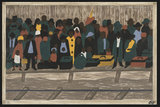 |
Migration Series: And the migrants kept coming | | Image |
| 106 |
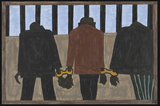 |
Migration Series: Another of the social causes of the migrants' leaving was that at times they did not feel safe, or it was not the best thing to be found on the streets late at night. They were arrested on the slightest provocation | | Image |
| 107 |
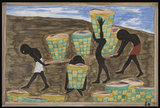 |
Migration Series: Child labor and a lack of education was one of the other reasons for people wishing to leave their homes | | Image |
| 108 |
 |
Migration Series: Housing for the Negroes was a very difficult problem | | Image |
| 109 |
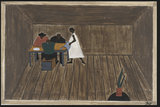 |
Migration Series: In every home people who had not gone North met and tried to decide if they should go North or not | | Image |
| 110 |
 |
Migration Series: In many of the communities the Negro press was read continually because of its attitude and its encouragement of the movement | | Image |
| 111 |
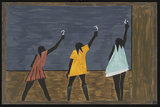 |
Migration Series: In the North the Negro had better educational facilities | | Image |
| 112 |
 |
Migration Series: Industries attempted to board their labor in quarters that were oftentimes very unhealthy. Labor camps were numerous | | Image |
| 113 |
 |
Migration Series: Living conditions were better in the North | | Image |
| 114 |
 |
Migration Series: One of the largest race riots occurred in East St. Louis | | Image |
| 115 |
 |
Migration Series: One of the main forms of social and recreational activities in which the migrants indulged occurred in the church | | Image |
| 116 |
 |
Migration Series: Race riots were very numerous all over the North because of the antagonism that was caused between the Negro and white workers. Many of these riots occurred because the Negro was used as a strike breaker in many of the Northern industries | | Image |
| 117 |
 |
Migration Series: The labor agent who had been sent South by Northern industry was a very familiar person in the Negro counties | | Image |
| 118 |
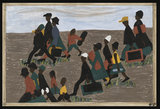 |
Migration Series: The migrants arrived in great numbers | | Image |
| 119 |
 |
Migration Series: The migration gained in momentum | | Image |
| 120 |
 |
Migration Series: The Negro press was also influential in urging the people to leave the South | | Image |
| 121 |
 |
Migration Series: The Negro was the largest source of labor to be found after all others had been exhausted | | Image |
| 122 |
 |
Migration Series: The railroad stations in the South were crowded with people leaving for the North | | Image |
| 123 |
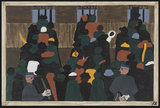 |
Migration Series: The railroad stations were at times so over-packed with people leaving that special guards had to be called in to keep order | | Image |
| 124 |
 |
Migration Series: The trains were packed continually with migrants | | Image |
| 125 |
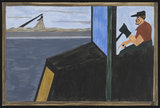 |
Migration Series: The World War had caused a great shortage in Northern industry and also citizens of foreign countries were returning home | | Image |
| 126 |
 |
Migration Series: They also made it very difficult for migrants leaving the South. They often went to railroad stations and arrested the Negroes wholesale, which in turn made them miss their train | | Image |
| 127 |
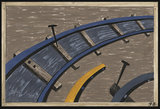 |
Migration Series: They also worked in large numbers on the railroad | | Image |
| 128 |
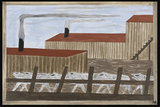 |
Migration Series: They arrived in great numbers into Chicago, the gateway of the West | | Image |
| 129 |
 |
Migration Series: They did not always leave because they were promised work in the North. Many of them left because of Southern conditions,; one of them being great floods that ruined the crops, and therefore they were unable to make a living where they were | | Image |
| 130 |
 |
Migration Series: They were very poor | | Image |
| 131 |
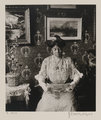 |
Miss Suzie Porter, Harlem | | Image |
| 132 |
 |
Mrs. Turner | | Image |
| 133 |
 |
Norman Lewis | | Image |
| 134 |
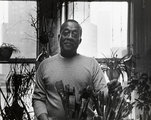 |
Norman Lewis in his Studio | | Image |
| 135 |
 |
Norman Lewis painting 'Composition I' | | Image |
| 136 |
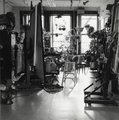 |
Norman Lewis' Studio | | Image |
| 137 |
 |
Nous Quatre a Paris (We Four in Paris) | | Image |
| 138 |
 |
Nude, Harlem | | Image |
| 139 |
 |
Palmer Hayden | | Image |
| 140 |
 |
The Photographer | | Image |
| 141 |
 |
Pin | | Image |
| 142 |
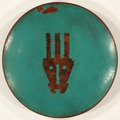 |
Plate | | Image |
| 143 |
 |
Pool Parlor | | Image |
| 144 |
 |
Portrait of a Couple, Man with a Walking Stick | | Image |
| 145 |
 |
Portrait of a Woman | | Image |
| 146 |
 |
Portrait of an Actor, Harlem | | Image |
| 147 |
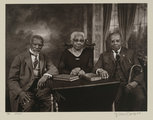 |
Portrait of Two Brothers and Their Sister | | Image |
| 148 |
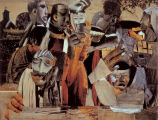 |
Prevalence of Ritual: Baptism | | Image |
| 149 |
 |
The Prodigal Son | | Image |
| 150 |
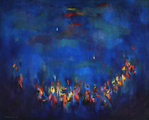 |
Ritual | | Image |
| 151 |
 |
Science | | Image |
| 152 |
 |
Sedation | | Image |
| 153 |
 |
Self-Portrait | | Image |
| 154 |
 |
Serenade | | Image |
| 155 |
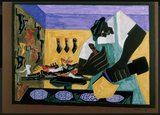 |
The Shoemaker | | Image |
| 156 |
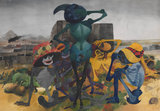 |
Skeleton Party | | Image |
| 157 |
 |
Slavery Through Reconstruction: Aspects of Negro Life | | Image |
| 158 |
 |
The Snack Bar | | Image |
| 159 |
 |
Soldiers at Rye | | Image |
| 160 |
 |
Spirituals (Dreams) | | Image |
| 161 |
 |
Street Life, Harlem | | Image |
| 162 |
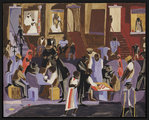 |
Street Shadows | | Image |
| 163 |
 |
The Subway | | Image |
| 164 |
 |
Swimming Team, Harlem | | Image |
| 165 |
 |
Title Unknown (March on Washington) | | Image |
| 166 |
 |
Toussaint L'Ouverture series, panel no. 10: The cruelty of the planters towards the slaves drove the slaves to revolt, 1776. Those revolts, which kept cropping up from time to time, finally came to a head in the rebellion | | Image |
| 167 |
 |
Toussaint L'Ouverture series, panel no. 11: The society of the Friends of the Blacks was formed in England, 1778, the leading members being Price, Priestly, Sharp, Clarkson, and Wilberforce | | Image |
| 168 |
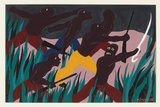 |
Toussaint L'Ouverture series, panel no. 12: Jean Francois, first Black to rebel in Haiti | | Image |
| 169 |
 |
Toussaint L'Ouverture series, panel no. 13: During the rebellion of Jean Francois, Toussaint led his master and mistress to safety | | Image |
| 170 |
 |
Toussaint L'Ouverture series, panel no. 14: The blacks were led by three chiefs, Jean Francois, Biassou, and Jeannot; Toussaint serving as aide-de-camp to Biassou | | Image |
| 171 |
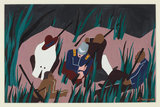 |
Toussaint L'Ouverture series, panel no. 15: The Mulattoes, enemies of both the Blacks and Whites, but tolerated more by the Whites, joined their forces in battle against the Blacks, 1793 | | Image |
| 172 |
 |
Toussaint L'Ouverture series, panel no. 16: Toussaint captured Dondon, a city in the center of Haiti, 1795 | | Image |
| 173 |
 |
Toussaint L'Ouverture series, panel no. 17: Toussaint captured Marmelade, held by Vernet, a mulatto, 1795 | | Image |
| 174 |
 |
Toussaint L'Ouverture series, panel no. 18: Toussaint captured Ennery | | Image |
| 175 |
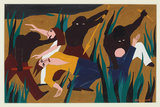 |
Toussaint L'Ouverture series, panel no. 19: The Mulattoes had no organization; the English held only a point or two on the Island, while the Blacks formed into large bands and slaughtered every Mulatto and White they encountered. The Blacks learned the secret of their power. The Haitians now controlled half the Island | | Image |
| 176 |
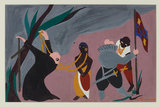 |
Toussaint L'Ouverture series, panel no. 1: Columbus discovered Haiti on December 6, 1492. The discovery was on Columbus' first trip to the New World. He is shown planting the official Spanish flag, under which he sailed. The priest shows the influence of the Church upon people | | Image |
| 177 |
 |
Toussaint L'Ouverture series, panel no. 20: General Toussaint L'Ouverture, Statesman and military genius, esteemed by the Spaniards, feared by the English, dreaded by the French, hated by the planters, and reverenced by the Blacks | | Image |
| 178 |
 |
Toussaint L'Ouverture series, panel no. 21: General Toussaint L'Ouverture attacked the English at Artibonite and there captured two towns | | Image |
| 179 |
 |
Toussaint L'Ouverture series, panel no. 22: Settling down at St. Marc, he took possession of two important posts | | Image |
| 180 |
 |
Toussaint L'Ouverture series, panel no. 23: General L'Ouverture collected forces at Marmelade, and on October the 9th, 1794, left with 500 men to capture San Miguel | | Image |
| 181 |
 |
Toussaint L'Ouverture series, panel no. 24: General L'Ouverture confers with Leveaux at Dondon with his principal aides, Dessalines, Commander of San Miguel, Duminil, Commander of Plaisaince, Desrouleaux, Ceveaux and Maurepas, Commanders of the Battalions, and prepares an attack at St. Marc | | Image |
| 182 |
 |
Toussaint L'Ouverture series, panel no. 25: General Toussaint L'Ouverture defeats the English at Saline | | Image |
| 183 |
 |
Toussaint L'Ouverture series, panel no. 26: On March 24, he captured Mirebalois | | Image |
| 184 |
 |
Toussaint L'Ouverture series, panel no. 27: Returning to private life as the commander and chief of the army, he saw to it that the country was well taken care of, and Haiti returned to prosperity. During this important period, slavery was abolished, and attention focused upon agricultural pursuits | | Image |
| 185 |
 |
Toussaint L'Ouverture series, panel no. 28: The constitution was prepared and presented to Toussaint on the 19th day of May, 1800, by nine men he had chosen, eight of whom were white properietors and one mulatto. Toussaint's liberalism led him to choose such a group to draw up the constitution. He was much criticized for his choice, but the constitution proved workable | | Image |
| 186 |
 |
Toussaint L'Ouverture series, panel no. 29: L'Ouverture made a triumphant march into San Domingo on the 2nd of January, 1801, at the head of 10,000 men, and hoisted the flag of the French Republic. Toussaint did not wish to break with the French, the largest group of Haitian inhabitants. The Blacks themselves spoke patois French | | Image |
| 187 |
 |
Toussaint L'Ouverture series, panel no. 2: Mistreatment by the Spanish soldiers caused much trouble on the island and caused the death of Anacanca, a native queen, 1503. Columbus left soldiers in charge, who began making slaves of the people. The queen was one of the leaders of the insurrection which followed | | Image |
| 188 |
 |
Toussaint L'Ouverture series, panel no. 30: Napoleon Bonaparte begins to look on Haiti as a new land to conquer. Conquest inevitably meant further slavery | | Image |
| 189 |
 |
Toussaint L'Ouverture series, panel no. 31: Napoleon's troops under LeClerc arrive at the shores of Haiti | | Image |
| 190 |
 |
Toussaint L'Ouverture series, panel no. 32: Henri Christoph, rather than surrender to LeClerc, sets fire to La Cape. Christoph, one of Toussaint's aides, sent word that the French were in Haitian waters - that he had held them off as long as possible | | Image |
| 191 |
 |
Toussaint L'Ouverture series, panel no. 33: General L'Ouverture, set for war with Napoleon, prepares Crete-a-Pierrot as a point of resitance. Toussaint took his troops into the mountains, deciding upon guerilla warfare | | Image |
| 192 |
 |
Toussaint L'Ouverture series, panel no. 34: Toussaint defeats Napoleon's troops at Ennery | | Image |
| 193 |
 |
Toussaint L'Ouverture series, panel no. 35: Yellow fever broke out with great violence, thus having a great physical and moral effect on the French soldiers. The French sought a truce with L'Ouverture | | Image |
| 194 |
 |
Toussaint L'Ouverture series, panel no. 36: During the truce Toussaint is deceived and arrested by LeClerc. LeClerc felt that with Toussaint out of the way, the Blacks would surrender | | Image |
| 195 |
 |
Toussaint L'Ouverture series, panel no. 37: Toussaint is taken to Paris and imprisoned in the dungeon of the Castle Joux - August 17, 1802 | | Image |
| 196 |
 |
Toussaint L'Ouverture series, panel no. 38: Napoleon's attempt to restore slavery in Haiti was unsuccessful. Dessalines, Chief of the Blacks, defeated LeClerc. Black men, women, and children took up arms to preserve their freedom | | Image |
| 197 |
 |
Toussaint L'Ouverture series, panel no. 39: The death of Toussaint L'Ouverture in the Prison of Le Joux, April, 1803. Imprisoned a year, Toussaint died of a broken heart | | Image |
| 198 |
 |
Toussaint L'Ouverture series, panel no. 3: Spain and France fought for Haiti constantly | | Image |
| 199 |
 |
Toussaint L'Ouverture series, panel no. 40: The Declaration of Independence was signed January 1, 1804 - Dessalines, Clevaux, and Henri Christoph. These three men made up a new constitution, writing it themselves. The Haitian flag shows in the sketch | | Image |
| 200 |
 |
Toussaint L'Ouverture series, panel no. 41: Dessalines was crowned Emperor October 4, 1804, thus: Jean Jacques the First of Haiti. Dessalines, standing beside a broken chain, had the powers of dictator, as opposed to Toussaint's more liberal leadership | | Image |